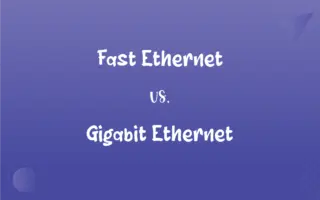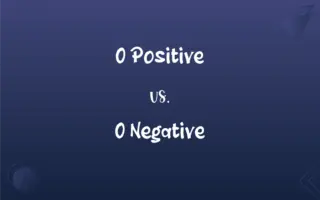Windows 8 vs. Windows 10: What's the Difference?
Edited by Aimie Carlson || By Harlon Moss || Updated on October 12, 2023
Windows 8 introduced a touch-optimized interface and a Start screen, while Windows 10 blended traditional desktop usability with enhanced features, including a revitalized Start menu, improved security, and more compatibility.

Key Differences
Windows 8 was designed with a significant emphasis on touch-friendly interfaces, making it quite suitable for tablets and devices with touchscreens. It introduced the tile-based Start screen, which displayed all applications in a tile format. On the other hand, Windows 10 provides a more hybrid approach, offering both the traditional desktop environment and the tile-based interface for touch-enabled devices. It reintroduced the Start menu that was absent in Windows 8, allowing users to access apps and settings directly from the desktop.
While Windows 8 was a shift towards a modern, touch-based design, it faced criticism for its steep learning curve, especially for users without touch-enabled devices. Traditional desktop users found the tile-based interface to be a deviation from the familiar desktop environment. Windows 10, learning from the feedback, brought back familiarity to users by reviving the Start menu, incorporating Live Tiles in a way that didn’t alienate traditional desktop users, and by providing a more seamless transition between touch and non-touch interfaces.
Security features in Windows 8 and Windows 10 also saw considerable evolution. Windows 8 brought notable security improvements, such as a built-in antivirus program (Windows Defender) and a secure boot feature. Whereas Windows 10 took security a step further, introducing features like Windows Hello, which allows users to log in using facial recognition, fingerprint scanning, and offering more robust, frequent, and streamlined security updates, in addition to enhanced parental controls and device encryption capabilities.
Integration with other devices and services also evolved from Windows 8 to Windows 10. Windows 8 offered a degree of synchronization with other devices via a Microsoft account, but Windows 10 enhanced cross-device experiences. Windows 10 provides a more harmonious environment with various devices, through features like “Continue on PC” for mobile devices, and greater synergy with Xbox consoles, enhancing gaming experiences with features like Game Mode and DirectX 12, which weren’t present in Windows 8.
Ultimately, Windows 10 offered a more mature, flexible, and secure user experience, learning and adapting from the feedback received from Windows 8 users. Windows 8 was a bold step into touch-optimized computing for Microsoft, but it’s Windows 10 that refined the user experience, offering a blend of the traditional computing environment, improved functionality, and an enhanced suite of features, making it appealing to a broader user base and a variety of device form factors.
ADVERTISEMENT
Comparison Chart
User Interface
Tile-based Start screen
Start menu with Live Tiles
Security Features
Secure boot, Windows Defender
Windows Hello, enhanced updates, DirectX 12
Usability
Optimized for touch devices
Balanced for touch and non-touch devices
System Menu
Lacks a traditional Start menu
Reintroduced and enhanced Start menu
Cross-Device Experience
Limited synchronization with Microsoft account
Enhanced sync and features across devices
ADVERTISEMENT
Windows 8 and Windows 10 Definitions
Windows 8
Windows 8 is an operating system designed by Microsoft, notable for introducing a touch-optimized, tile-based user interface.
Windows 8 was often found on tablets due to its touch-friendly design.
Windows 10
Windows 10 provides a unified environment, offering compatibility and synchronization features across various devices.
Using Continue on PC, Windows 10 allows users to start work on their phones and seamlessly shift it to their PCs.
Windows 8
Windows 8 focused heavily on a seamless user experience for touch-based devices, such as tablets and hybrid laptops.
The tile-based layout of Windows 8 was well-suited for tapping and swiping on touchscreen devices.
Windows 10
Windows 10 introduces DirectX 12, improving graphics technology and providing richer gaming experiences.
Gamers on Windows 10 enjoy the benefits of DirectX 12, enhancing visuals and performance in supported games.
Windows 8
Windows 8 introduced a new Windows Store from which users could download apps designed for the new interface.
The Windows Store in Windows 8 offered a variety of applications tailored for the touch-centric interface.
Windows 10
Windows 10 is an operating system developed by Microsoft, offering a balanced interface for both touch and non-touch devices.
Windows 10 harmoniously merges traditional desktop layouts with modern touch-friendly designs.
Windows 8
Windows 8 implemented enhanced security features, such as secure boot and improved Windows Defender.
With Windows 8, secure boot technology helped protect the boot process from malicious software.
Windows 10
Windows 10 reintroduced the Start menu, integrating it with live tiles to provide quick access to applications and notifications.
The Start menu in Windows 10 provides users with one-click access to their applications and settings.
Windows 8
Windows 8 presented a departure from traditional Windows user interfaces, eliminating the Start menu in favor of a Start screen.
Users had to adapt to the absence of a Start menu when Windows 8 was launched.
Windows 10
Windows 10 emphasizes enhanced security features, including Windows Hello and regular, streamlined updates.
Windows 10 users can utilize Windows Hello to log in using facial recognition or fingerprints.
FAQs
What is Windows 8?
Windows 8 is an operating system by Microsoft, known for its tile-based, touch-friendly interface.
Did Windows 10 reintroduce the Start menu?
Yes, Windows 10 brought back the Start menu, with the integration of live tiles.
Was Windows 8 optimized for touch devices?
Yes, Windows 8 featured a touch-optimized interface, particularly suitable for tablets.
What is Windows 10?
Windows 10 is a versatile operating system from Microsoft that caters to both touch and traditional computing environments.
Does Windows 10 have enhanced security features?
Yes, Windows 10 introduced Windows Hello and provides regular, streamlined security updates.
Was Windows 8 available in various editions?
Yes, Windows 8 was available in different editions, each tailored for different user needs and device types.
Does Windows 10 receive regular feature updates?
Yes, Windows 10 has received regular feature updates since its release, enhancing functionality and security.
Does Windows 8 have a Start menu?
No, Windows 8 replaced the traditional Start menu with a tile-based Start screen.
What is DirectX 12 in Windows 10?
DirectX 12, exclusive to Windows 10, enhances gaming graphics and performance.
Are both Windows 8 and Windows 10 suitable for gaming?
Yes, both are suitable, but Windows 10 provides additional benefits like DirectX 12 for enhanced gaming experiences.
Does Windows 10 offer a virtual desktop feature?
Yes, Windows 10 introduced a virtual desktop feature, allowing users to create multiple desktop environments.
Can Windows 8 run traditional desktop applications?
Yes, Windows 8 can run traditional desktop applications alongside apps from the Windows Store.
Is Windows 10 compatible with older applications?
Generally, yes; Windows 10 maintains compatibility with a wide range of older applications.
Is Windows 8.1 an improved version of Windows 8?
Yes, Windows 8.1 introduced improvements and features to address some criticisms of Windows 8.
What is Windows Hello?
Windows Hello is a security feature in Windows 10 enabling biometric authentication, like facial recognition and fingerprint scanning.
Did Windows 8 face criticism for its user interface?
Yes, Windows 8 received criticism for its deviation from traditional desktop interfaces and its steep learning curve.
Can Windows 10 sync settings across devices?
Yes, Windows 10 can synchronize settings, apps, and files across devices using a Microsoft account.
Which is considered more user-friendly, Windows 8 or Windows 10?
Windows 10 is often considered more user-friendly due to its hybrid interface and refined features.
How does Windows 10 improve upon Windows 8’s interface?
Windows 10 reintegrates the Start menu and harmonizes touch and non-touch user interfaces.
Can Windows 8 be upgraded to Windows 10?
Yes, eligible Windows 8 devices were offered a free upgrade to Windows 10 for a limited period post-launch, and now it may require a purchase.
About Author
Written by
Harlon MossHarlon is a seasoned quality moderator and accomplished content writer for Difference Wiki. An alumnus of the prestigious University of California, he earned his degree in Computer Science. Leveraging his academic background, Harlon brings a meticulous and informed perspective to his work, ensuring content accuracy and excellence.
Edited by
Aimie CarlsonAimie Carlson, holding a master's degree in English literature, is a fervent English language enthusiast. She lends her writing talents to Difference Wiki, a prominent website that specializes in comparisons, offering readers insightful analyses that both captivate and inform.































































